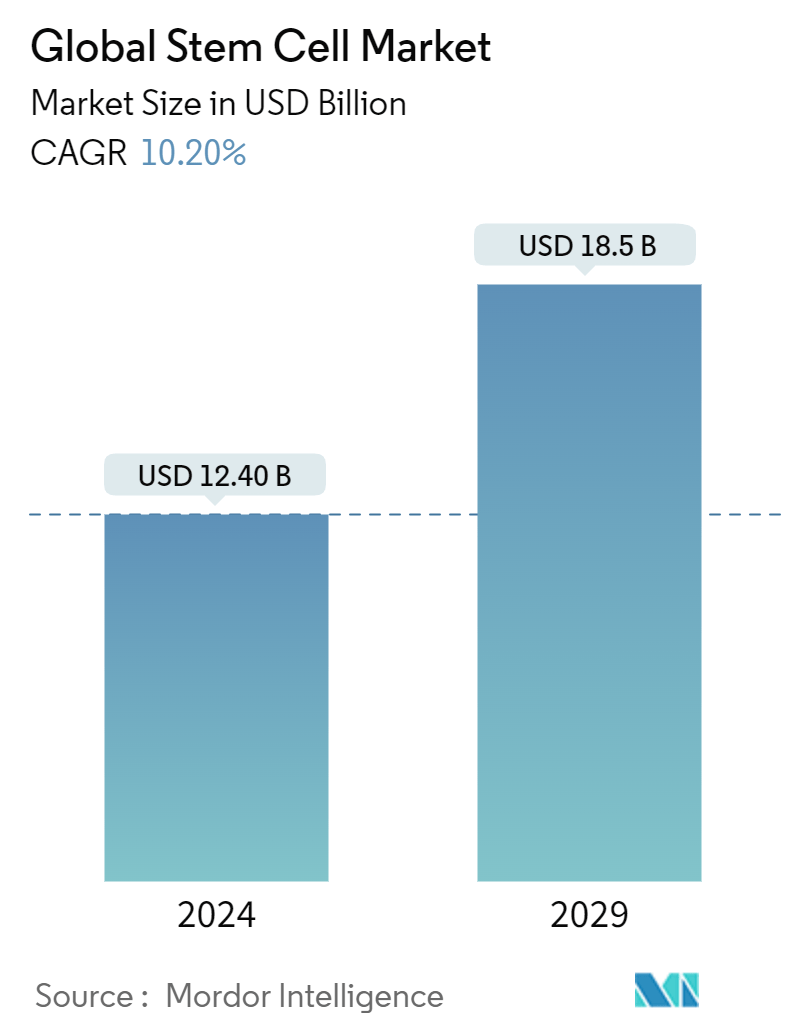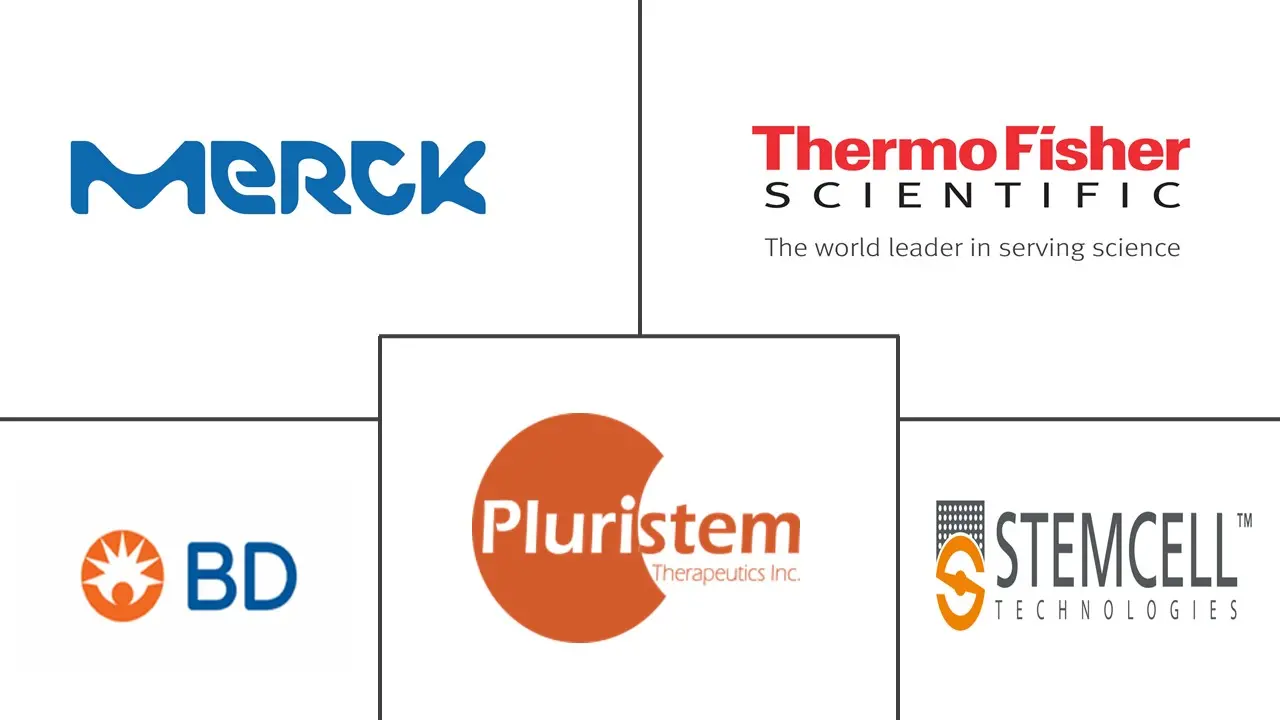Market Size of Global Stem Cell Industry

| Study Period | 2019 - 2029 |
| Market Size (2024) | USD 12.40 Billion |
| Market Size (2029) | USD 18.5 Billion |
| CAGR (2024 - 2029) | 10.20 % |
| Fastest Growing Market | Asia Pacific |
| Largest Market | North America |
Major Players
*Disclaimer: Major Players sorted in no particular order |
Need a report that reflects how COVID-19 has impacted this market and its growth?
Global Stem Cell Market Analysis
The Global Stem Cell Market size is estimated at USD 12.40 billion in 2024, and is expected to reach USD 18.5 billion by 2029, growing at a CAGR of 10.20% during the forecast period (2024-2029).
Increased awareness about umbilical stem cells, growing demand for regenerative treatment options, and rising research and development initiatives to develop stem cell therapies are some of the major factors expected to drive the global market. In addition, increasing funding/grants for developing stem cell therapies is another factor projected to support the industry's expansion.
Increasing awareness about stem cells and their applications in advanced therapeutics like regenerative medicine and stem cell therapies is one of the major drivers of the market. For instance, according to an article published by Inflammation and Regeneration in December 2023, there is an increase in awareness levels of stem cells and their applications among people, and stem cells isolated from the umbilical cord are the effective off-the-shelve sources for cell and gene therapies in regenerative medicine and immunotherapies. Thus, such applications of stem cells in developing advanced therapeutics are key factors driving market growth.
In addition, the increase in the prevalence of chronic diseases and the growing implication of regenerative stem cell therapies in chronic diseases is another factor expected to support industry growth. For instance, according to a journal published by the American Heart Association, in March 2023, there were around 56.19 million heart failure cases globally. Thus, such an alarming increase in the burden of chronic diseases is expected to foster demand for innovative regenerative therapies for heart diseases, which, in turn, is expected to accelerate market growth.
The increased burden of chronic diseases has facilitated research efforts in regenerative stem cell therapy to develop promising therapeutics for such diseases. For instance, in December 2023, researchers from the Mayo Clinic and international collaborators demonstrated the effective role of stem cell-based regenerative therapy in advanced heart failure.
In January 2024, a stem cell therapy developed by UC Davis Health researchers for Crohn’s disease showed promising effects in preclinical trials. Thus, increased research efforts in the stem cell therapy are projected to facilitate industry expansion during the forecast period.
Moreover, the increased funding/grants to develop promising stem cell-based therapeutics are further projected to support the market growth. For instance, in January 2024, CellVoyant received funding of GBP 7.6 million (USD 9.49 million) from Octopus Ventures to boost its efforts to develop advanced stem cell therapies for managing several life-threatening conditions. Similarly, in February 2023, the National Institutes of Health granted USD 2.5 million to the research team of Purdue University to accelerate their stem cell research. Thus, such increased funding activities are anticipated to cater to industry expansion.
Several strategic initiatives market players undertake are further projected to spur market growth. For instance, in April 2023, Gamida Cell Ltd, a cell therapy leader, announced US FDA approval of Omisirge, an allogeneic cell therapy for treating pediatric patients and adults with hematologic malignancies. This approval will likely increase stem cell transplant access and improve patient outcomes. Thus, such initiatives will likely foster market expansion during the forecast period.
Thus, owing to the abovementioned factors, such as the growing demand for regenerative medicine, increased burden of chronic diseases, the growing role of stem cells in the management of chronic disease, and increasing grants/funding for stem cell therapeutics are expected to offer significant growth for the market during the forecast period. However, expensive procedures, regulatory complications, and ethical and moral frameworks may hinder the market's growth.
Global Stem Cell Industry Segmentation
As per the scope of the report, stem cells are biological cells that can differentiate into other types of cells. Additionally, various types of stem cells are used for therapeutic purposes. With multiple applications at the clinical stage for various diseases, these are being explored extensively by many biopharmaceutical companies in recent times. The stem cells market is segmented by product type, application, treatment type, and geography. By product type, the market is segmented as adult stem cells, human embryonic cells, pluripotent stem cells, and other product types. By application, the market is segmented as neurological disorders, orthopedic treatments, oncology disorders, injuries and wounds, cardiovascular disorders, and other applications. By treatment type, the market is segmented as allogeneic stem cell therapy, auto-logic stem cell therapy, and syngeneic stem cell therapy. The report also covers the market sizes and forecasts for the stem cells market in major countries across different regions. For each segment, the market size is provided in terms of value (USD).
| By Product Type | |
| Adult Stem Cell | |
| Human Embryonic Cell | |
| Pluripotent Stem Cell | |
| Other Product Types |
| By Application | |
| Neurological Disorders | |
| Orthopedic Treatments | |
| Oncology Disorders | |
| Injuries and Wounds | |
| Cardiovascular Disorders | |
| Other Applications |
| By Treatment Type | |
| Allogeneic Stem Cell Therapy | |
| Autologic Stem Cell Therapy | |
| Syngeneic Stem Cell Therapy |
| Geography | ||||||||
| ||||||||
| ||||||||
| ||||||||
| ||||||||
|
Global Stem Cell Market Size Summary
The global stem cell market is poised for significant growth, driven by increasing awareness and demand for regenerative treatment options. The market is expected to expand substantially over the forecast period, supported by rising research and development initiatives aimed at developing advanced stem cell therapies. The growing prevalence of chronic diseases and the application of regenerative stem cell therapies in their management are key factors propelling market expansion. Additionally, increased funding and grants for stem cell research are anticipated to further bolster the industry's growth. Strategic initiatives by market players, such as regulatory approvals and collaborations, are also expected to contribute to the market's upward trajectory.
North America is projected to experience robust growth in the stem cell market, fueled by a rising burden of chronic diseases and a supportive regulatory environment. The region's focus on research and the adoption of regenerative medicine are key drivers of this growth. The increasing prevalence of cancer in the United States is expected to boost demand for advanced cancer therapies, including stem cell treatments. The competitive landscape of the market is characterized by the presence of major players who are advancing stem cell technology, thereby intensifying market rivalry. Collaborative efforts and strategic partnerships among industry participants are likely to enhance the development and commercialization of stem cell-based therapeutics, further propelling market growth.
Global Stem Cell Market Size - Table of Contents
-
1. MARKET DYNAMICS
-
1.1 Market Overview
-
1.2 Market Drivers
-
1.2.1 Growing Demand For Stem Cell Banking
-
1.2.2 Increasing Prevalence Of Chronic Disorders
-
1.2.3 Ongoing Developments In Regenerative Medicine
-
1.2.4 Rising Funds For Accelerating Stem Cell Research
-
-
1.3 Market Restraints
-
1.3.1 Expensive Procedures
-
1.3.2 Regulatory Complications and Ethical and Moral Framework
-
-
1.4 Industry Attractiveness- Porter's Five Forces Analysis
-
1.4.1 Threat of New Entrants
-
1.4.2 Bargaining Power of Buyers/Consumers
-
1.4.3 Bargaining Power of Suppliers
-
1.4.4 Threat of Substitute Products
-
1.4.5 Intensity of Competitive Rivalry
-
-
-
2. MARKET SEGMENTATION (Market Size by Value - USD)
-
2.1 By Product Type
-
2.1.1 Adult Stem Cell
-
2.1.2 Human Embryonic Cell
-
2.1.3 Pluripotent Stem Cell
-
2.1.4 Other Product Types
-
-
2.2 By Application
-
2.2.1 Neurological Disorders
-
2.2.2 Orthopedic Treatments
-
2.2.3 Oncology Disorders
-
2.2.4 Injuries and Wounds
-
2.2.5 Cardiovascular Disorders
-
2.2.6 Other Applications
-
-
2.3 By Treatment Type
-
2.3.1 Allogeneic Stem Cell Therapy
-
2.3.2 Autologic Stem Cell Therapy
-
2.3.3 Syngeneic Stem Cell Therapy
-
-
2.4 Geography
-
2.4.1 North America
-
2.4.1.1 United States
-
2.4.1.2 Canada
-
2.4.1.3 Mexico
-
-
2.4.2 Europe
-
2.4.2.1 United Kingdom
-
2.4.2.2 Germany
-
2.4.2.3 France
-
2.4.2.4 Italy
-
2.4.2.5 Spain
-
2.4.2.6 Rest of Europe
-
-
2.4.3 Asia-Pacific
-
2.4.3.1 China
-
2.4.3.2 Japan
-
2.4.3.3 India
-
2.4.3.4 Australia
-
2.4.3.5 South Korea
-
2.4.3.6 Rest of Asia-Pacific
-
-
2.4.4 Middle East and Africa
-
2.4.4.1 GCC
-
2.4.4.2 South Africa
-
2.4.4.3 Rest of Middle East and Africa
-
-
2.4.5 South America
-
2.4.5.1 Brazil
-
2.4.5.2 Argentina
-
2.4.5.3 Rest of South America
-
-
-
Global Stem Cell Market Size FAQs
How big is the Global Stem Cell Market?
The Global Stem Cell Market size is expected to reach USD 12.40 billion in 2024 and grow at a CAGR of 10.20% to reach USD 18.5 billion by 2029.
What is the current Global Stem Cell Market size?
In 2024, the Global Stem Cell Market size is expected to reach USD 12.40 billion.

